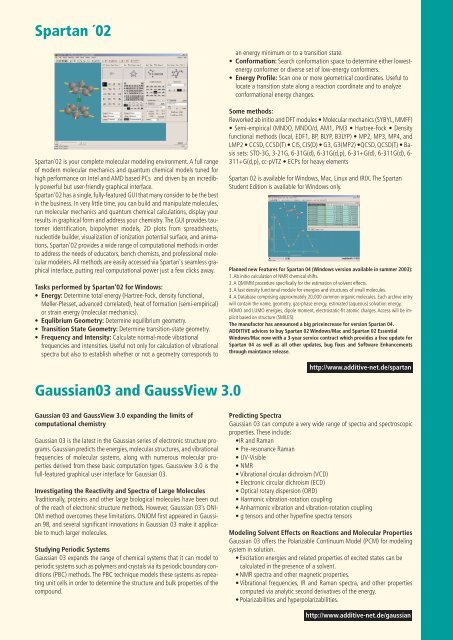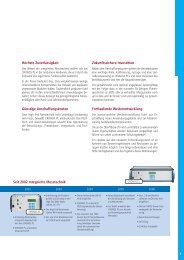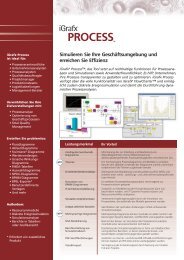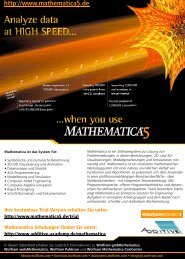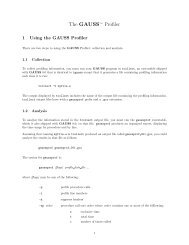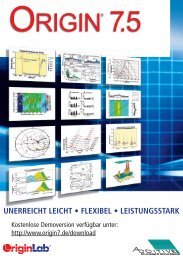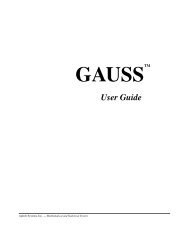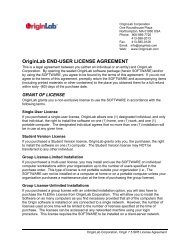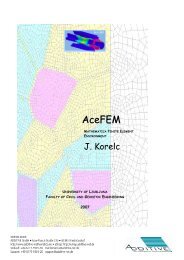Chemoffice Ultra 04 Ultimate Drawing, Modeling & Information Suite
Chemoffice Ultra 04 Ultimate Drawing, Modeling & Information Suite
Chemoffice Ultra 04 Ultimate Drawing, Modeling & Information Suite
Create successful ePaper yourself
Turn your PDF publications into a flip-book with our unique Google optimized e-Paper software.
Spartan ´02<br />
Spartan´02 is your complete molecular modeling environment. A full range<br />
of modern molecular mechanics and quantum chemical models tuned for<br />
high performance on Intel and AMD based PCs and driven by an incredibly<br />
powerful but user-friendly graphical interface.<br />
Spartan'02 has a single, fully-featured GUI that many consider to be the best<br />
in the business. In very little time, you can build and manipulate molecules,<br />
run molecular mechanics and quantum chemical calculations, display your<br />
results in graphical form and address your chemistry.The GUI provides tautomer<br />
identification, biopolymer models, 2D plots from spreadsheets,<br />
nucleotide builder, visualization of ionization potential surface, and animations.<br />
Spartan'02 provides a wide range of computational methods in order<br />
to address the needs of educators, bench chemists, and professional molecular<br />
modelers.All methods are easily accessed via Spartan's seamless graphical<br />
interface, putting real computational power just a few clicks away.<br />
Tasks performed by Spartan'02 for Windows:<br />
• Energy: Determine total energy (Hartree-Fock, density functional,<br />
Møller-Plesset, advanced correlated), heat of formation (semi-empirical)<br />
or strain energy (molecular mechanics).<br />
• Equlibrium Geometry: Determine equilibrium geometry.<br />
• Transition State Geometry: Determine transition-state geometry.<br />
• Frequency and Intensity: Calculate normal-mode vibrational<br />
frequencies and intensities. Useful not only for calculation of vibrational<br />
spectra but also to establish whether or not a geometry corresponds to<br />
Gaussian03 and GaussView 3.0<br />
Gaussian 03 and GaussView 3.0 expanding the limits of<br />
computational chemistry<br />
Gaussian 03 is the latest in the Gaussian series of electronic structure programs.<br />
Gaussian predicts the energies, molecular structures, and vibrational<br />
frequencies of molecular systems, along with numerous molecular properties<br />
derived from these basic computation types. Gaussview 3.0 is the<br />
full-featured graphical user interface for Gaussian 03.<br />
Investigating the Reactivity and Spectra of Large Molecules<br />
Traditionally, proteins and other large biological molecules have been out<br />
of the reach of electronic structure methods. However, Gaussian 03’s ONI-<br />
OM method overcomes these limitations. ONIOM first appeared in Gaussian<br />
98, and several significant innovations in Gaussian 03 make it applicable<br />
to much larger molecules.<br />
Studying Periodic Systems<br />
Gaussian 03 expands the range of chemical systems that it can model to<br />
periodic systems such as polymers and crystals via its periodic boundary conditions<br />
(PBC) methods. The PBC technique models these systems as repeating<br />
unit cells in order to determine the structure and bulk properties of the<br />
compound.<br />
an energy minimum or to a transition state.<br />
• Conformation: Search conformation space to determine either lowestenergy<br />
conformer or diverse set of low-energy conformers.<br />
• Energy Profile: Scan one or more geometrical coordinates. Useful to<br />
locate a transition state along a reaction coordinate and to analyze<br />
conformational energy changes.<br />
Some methods:<br />
Reworked ab initio and DFT modules • Molecular mechanics (SYBYL, MMFF)<br />
• Semi-empirical (MNDO, MNDO/d, AM1, PM3 • Hartree-Fock • Density<br />
functional methods (local, EDF1, BP, BLYP, B3LYP) • MP2, MP3, MP4, and<br />
LMP2 • CCSD, CCSD(T) • CIS, CIS(D) • G3, G3(MP2) •QCSD, QCSD(T) • Basis<br />
sets: STO-3G, 3-21G, 6-31G(d), 6-31G(d,p), 6-31+G(d), 6-311G(d), 6-<br />
311+G(d,p), cc-pVTZ • ECPs for heavy elements<br />
Spartan 02 is available for Windows, Mac, Linux and IRIX. The Spartan<br />
Student Edition is available for Windows only.<br />
Planned new Features for Spartan <strong>04</strong> (Windows version available in summer 2003):<br />
1. Ab initio calculation of NMR chemical shifts.<br />
2. A QM/MM procedure specifically for the estimation of solvent effects.<br />
3. A fast density functional module for energies and structures of small molecules.<br />
4. A Database comprising approximately 20,000 common organic molecules. Each archive entry<br />
will contain the name, geometry, gas-phase energy, estimated (aqueous) solvation energy,<br />
HOMO and LUMO energies, dipole moment, electrostatic-fit atomic charges. Access will be implicit<br />
based on structure (SMILES).<br />
The manufactor has announced a big priceincrease for version Spartan <strong>04</strong>.<br />
ADDITIVE advices to buy Spartan 02 Windows/Mac and Spartan 02 Essential<br />
Windows/Mac now with a 3-year service contract which provides a free update for<br />
Spartan <strong>04</strong> as well as all other updates, bug fixes and Software Enhancements<br />
through maintance release.<br />
http://www.additive-net.de/spartan<br />
Predicting Spectra<br />
Gaussian 03 can compute a very wide range of spectra and spectroscopic<br />
properties. These include:<br />
•IR and Raman<br />
• Pre-resonance Raman<br />
• UV-Visible<br />
• NMR<br />
• Vibrational circular dichroism (VCD)<br />
• Electronic circular dichroism (ECD)<br />
• Optical rotary dispersion (ORD)<br />
• Harmonic vibration-rotation coupling<br />
• Anharmonic vibration and vibration-rotation coupling<br />
• g tensors and other hyperfine spectra tensors<br />
<strong>Modeling</strong> Solvent Effects on Reactions and Molecular Properties<br />
Gaussian 03 offers the Polarizable Continuum Model (PCM) for modeling<br />
system in solution.<br />
• Excitation energies and related properties of excited states can be<br />
calculated in the presence of a solvent.<br />
• NMR spectra and other magnetic properties.<br />
• Vibrational frequencies, IR and Raman spectra, and other properties<br />
computed via analytic second derivatives of the energy.<br />
• Polarizabilities and hyperpolarizabilities.<br />
http://www.additive-net.de/gaussian


